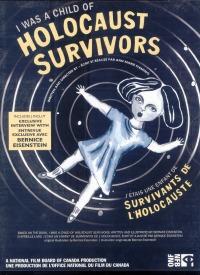| ________________
CM . . . . Volume XVIII Number 22 . . . . February 10, 2012
excerpt:
The death of which the narrator speaks is that of Bernice Eisenstein's father, and with that event she begins her memoir of life as a child of Holocaust survivors. Memory is rarely linear, and so Eisenstein then travels back in time to 1961. She is 11-years-old, and her family, as well as their friends, are gathered around a black and white television set, watching news coverage of the trail of Adolf Eichmann. Thus begins her understanding of the Holocaust as an historical "fact", as well as a fixation on learning everything she possibly can about that event. For her, the Holocaust is a reality of her environment. In 1948, Eisenstein's parents arrived in Toronto where her father set up shop as a kosher butcher in the Kensington area. Theirs was a tightly-bonded community, its own little village of family and friends who shared the same past and history. Despite being a member of this community, there is a part of herself who feels like an outsider because she did not experience the Holocaust directly. Eisenstein is obsessed with understanding the emotional impact of the Holocaust on her parents, and, of course, herself. She describes her father as being like "a caged animal", often angry and someone who escapes at the end of the working day to watch westerns on television. A conscript to the Polish cavalry of World War II, he ended up at Auschwitz where he was the only member of his family to survive the camp. Unlike the heroes of his beloved westerns, he could not save any of them. As for Eisenstein's mother, "she came to Canada", long before her 1948 arrival. She worked in the Birkenau camp, in a warehouse ironically named "Kanada" for its abundance of goods: clothing, shoes, and other items taken from people who arrived at the camp. One day, complaining of the cold, she asks if she may have one of the coats she is helping to sort. Finding a gold wedding ring in the pocked lining of the coat, she keeps it and later gives it to her husband, the only gift she could give him when they married. Eisenstein is pregnant at the time of her father's death, but her father says that she carries his name, and the film ends with her son's bris (the traditional Jewish ceremony of circumcision and naming), affirming that life continues. The film, itself, is short, only 15 minutes long, but there is an additional 45 minutes of interview segments in which Bernice Eisenstein describes the emotional needs which led to the writing and illustration of the book from which the film is adapted, her description of her own creative process, and responses to the book when she presented excerpts at public readings. Although the film can be viewed without viewing the interviews, I think that the interviews really provide an important dimension to understanding the film. And, in one of the interview segments, Eisenstein makes it clear that there is a universal dimension to the story: she states that this is "the story of immigrants from Europe." Indeed, the intensity of the community bonds is true of any group of new immigrants, particularly those who arrive in Canada as political refugees, the result of horrible war-time experiences. Despite everything, Bernice Eisenstein affirms that her parents were able to find joy in the "survival of spirit", and she tells their story with love and compassion for their experiences. I Was a Child of Holocaust Survivors contains both English and French-language audio tracks, although the interview segments are in English only. The illustrations remind one of the work of Marc Chagall, powerfully blending na´ve, magical, and realistic elements. The film has a natural place in any curriculum of Holocaust/Human Rights studies, although the content demands the emotional maturity of an older student. The film might also be useful in Art programs, especially because of Eisenstein's description of how the activities painting and writing each informed creation of ideas in the other medium. A thoughtful and thought-provoking exploration of personal identity. Highly Recommended. A retired teacher-librarian, Joanne Peters lives in Winnipeg, MB.
To comment
on this title or this review, send mail to cm@umanitoba.ca.
Copyright © the Manitoba Library Association. Reproduction for personal
use is permitted only if this copyright notice is maintained. Any
other reproduction is prohibited without permission.
NEXT REVIEW |
TABLE OF CONTENTS FOR THIS ISSUE
- February 10, 2012.
AUTHORS |
TITLES |
MEDIA REVIEWS |
PROFILES |
BACK ISSUES |
SEARCH |
CMARCHIVE |
HOME |
